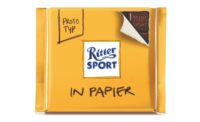Ritter Sport, which was founded in 1912, today manufactures all chocolate products at its German site in Waldenbuch, near Stuttgart. Sold in more than 100 countries, export counts for one third of its business.
It currently offers 22 flavors in its range, with an additional product line including six nut varieties, small and large formats (250 g bar, mini, chocolate cubes) and all new lactose-free and vegan varieties with great-sounding names like Quinoa and Amaranth. One of the key factors for its success comes from its unique packaging.
With vibrant colors and unmistakable square shape, people across the world instantly recognize the “Quality in a square” slogan that entices positive feeling towards the brand. What’s more, its vivid, lively packaging is easily opened with a snap, another distinct element which adds to the brand’s familiarity.
What is behind this variety? What technology and machines are used? Since 2000, Ritter has been working together with Bosch Packaging Technology to ensure the required market flexibility of its packaging production systems. From provisioning to order-related assembly, Bosch has been the partner of choice for flexible machinery.
As Klaus Hätinger, Ritter’s head of production technology, says: “For a long time, Bosch had been known to us as a provider of reliable packaging machinery and good service. However, we were won over by the way in which our real needs and requirements were considered and met. With the machines we use, we are in a position to convert to other formats within 10 to 15 minutes – without the need to use separate tools.”
Currently, Ritter operates a total of 22 Bosch systems in Waldenbuch, of which 19 are modular, servo-controlled flow wrappers.
The digitally controlled systems have a balcony construction with a steel frame and integrated control cabinet. The modules enable quick adaptation of the packaging process to different shapes and seals so that a variety of products can be packaged using just one machine.
“The short set-up times make it possible to cover many different formats with a single production line – previously, several machines were required,” Hätinger says.
The flow wrapper is operated either using a modern HMI with a 12.1-in. touchscreen or a panel with function buttons, a graphical display and a jogging wheel. Machine analysis can be performed via an integrated memory, which displays incidents for 24 hours including time data.
The entire system is controlled digitally and, depending on layout, can be operated with PLCs by different manufacturers. Film transportation and seal roll pressure are affected by servo drives connected to a high-speed motion controller via a servo interface; these make high speeds and maximum performance possible, even with hot sealing.
Crucial to the acceptance of the Bosch solution was the high degree of system effectiveness. Hätinger estimates that the overall equipment effectiveness (OEE) is around 98 percent, which is a direct consequence of the high performance of the individual machines.
He also points out that procurement costs are more than balanced out by the lifecycle costs: “With this solution, we achieve a high level of availability with minimal investment into spare parts, which prove to be cost–effective when calculated across the individual machines.”
Good service makes for good relationships
It is well known that the best service is the kind that is not needed. Unfortunately, the reality is often quite different. It is precisely here that Bosch proves its worth, Hätinger asserts.
“We can actually handle most things ourselves, but when a Bosch Packaging expert is needed, they respond quickly, providing a first-rate service,” he says. “The interpersonal relationship is very important for us, and this collaborative way of working has led to a high level of understanding between the two companies.”
It’s no coincidence that service quality derives from the design of the machines: The three separate access levels for operation, maintenance, and engineering make it easier for the user to independently carry out conversions, maintenance work and troubleshooting.
Therefore, if the packaging stage was once something of a bottleneck in the overall chocolate manufacturing process, it is now the reverse, says Hätinger. Packaging technology is almost faster than the chocolate production itself.
As Ritter’s head of production technology adds: “We are planning to install this solution for additional production lines. It is important to us that the systems are still available in 10 to 15 years so that future solutions can be implemented.”
For more information, visit www.boschpackaging.com
Meeting flexible pouch packaging needs
VOLPAK starts 2018 as the market leader in the HFFS pouching industry, a position it established and maintained thanks to a constant investment in technology. The Barcelona, Spain-based company, known as the “pouching partner” of reference, is constantly investing in innovation and new technology to develop machines tailored to the clients’ requests and that anticipate the trends and needs of an increasingly faster moving consumer goods market.
In this context, the company began the development of an innovative high-speed horizontal pouching machine, the ultimate breakthrough to be launched at mid-year that aims to become the highlight of the pouching technology.
The new machine will be at top of the line for performance, cost of production and efficiency, representing the ideal solution for companies with substantial needs in terms of high volumes without having to compromise in pouch quality.
The current portfolio, which includes SI-440 keeps, has raised considerable interest. This machine, previewed at last year’s interpack and currently VOLPAK’s flagship pouching machine among its wide intermittent HFFS machine portfolio, is able to run a wide range of pouch sizes, with high production rates and offers a high level of factory connectivity.
The innovative features that have contributed to its success will be rolled out to the SI series through 2018, which will now be “Industry 4.0 ready.”
There is also big news on the ENFLEX brand, as well: the machines for stand-up pouch and flat sachets are undergoing a restyling process, to continue improving their performance, and ergonomics. As with the SI line, the characteristics that have helped ENFLEX machines become bestsellers will stay the same, especially in terms of simplicity, quality and reliability.
For more information, visit www.volpak.com.






